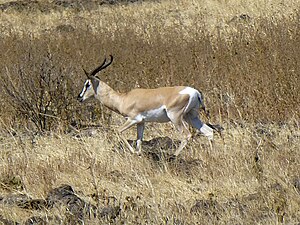Sömmerring Gazelle
| Sömmerring Gazelle | ||||||||||||
|---|---|---|---|---|---|---|---|---|---|---|---|---|

Summer ring gazelle ( Nanger soemmerringii ) |
||||||||||||
| Systematics | ||||||||||||
|
||||||||||||
| Scientific name | ||||||||||||
| Nanger soemmerringii | ||||||||||||
| ( Cretzschmar , 1828) |
The summer ring gazelle ( Nanger soemmerringii ) is an African antelope named after the German doctor and universal genius Samuel Thomas von Soemmerring .
External features
It is a large, weakly marked gazelle with a very white underside and distinctive facial markings. The head is relatively large with strong, short, lyre-shaped horns curved backwards. The tips are curved inwards like a hook. This horn shape is a distinctive distinguishing feature from all other gazelles. It has relatively long legs with strong hooves and a relatively short neck. The tail is short, fringed with light, short hair. It has pre-eye glands , but they are not used for marking. Shoulder height: 81 to 90 cm. Weight: 38 to 46 kg. Length: 125 to 150 cm.
Subspecies
- Nanger soemmerringii soemmerringii : shorter horns, brown face
- Nanger soemmerringii berberana : longer horns, black face
- Nanger soemmerringii butteri : dark flanks, striped thighs
distribution
Their distribution is limited (endemically) to the Horn of Africa, where they once populated most of Somalia and the low foothills of the Ethiopian highlands in the west and east. Here they gathered in their hundreds in the open plains. The current population, as far as is known, is limited to small island-like occurrences. They prefer hilly land with scattered evergreen bushes and acacias as well as the open grass steppe. Today they are rarely seen in herds that consist of more than 15 animals.
behavior
The herds are groups of females with their young, led by a buck in its area marked with dung and urine. Like the Grant's gazelles , they tilt their horns to the side and circle around each other when threatening gestures. If there is a conflict, they hook the horns on the side and try to throw the opponent off balance. When they gather or touch, they emit a nasal caw. The gestation period lasts approx. 198 days and the young remain in their hiding place for up to a month, surrounded by the mother. Sexual maturity is reached after 18 months and the animals can live up to 14 years.
Danger
Due to hunting and overgrazing by domestic cattle, they have largely disappeared from their original range. The current occurrence is limited to individual small territories. Efforts to establish protected areas have so far failed due to the persistently unsettled situation in the region. According to the IUCN list, they are classified as endangered.
literature
- Jonathan Kingdon: The Kingdon Field Guide To African Mammals . ISBN 0-7136-6513-0
- Grzimeks animal life . Volume 13: Mammals 4
- The IUCN Red List of Threatened Species: Gazella soemmerringii
Web links
- Nanger soemmerringii inthe IUCN Red List of Threatened Species 2013.1. Posted by: Heckel, J.-O., Wilhelmi, F., Kaariye, XY, Rayaleh, HA, Amir, OG & Künzel, T., 2008. Retrieved September 24, 2013.